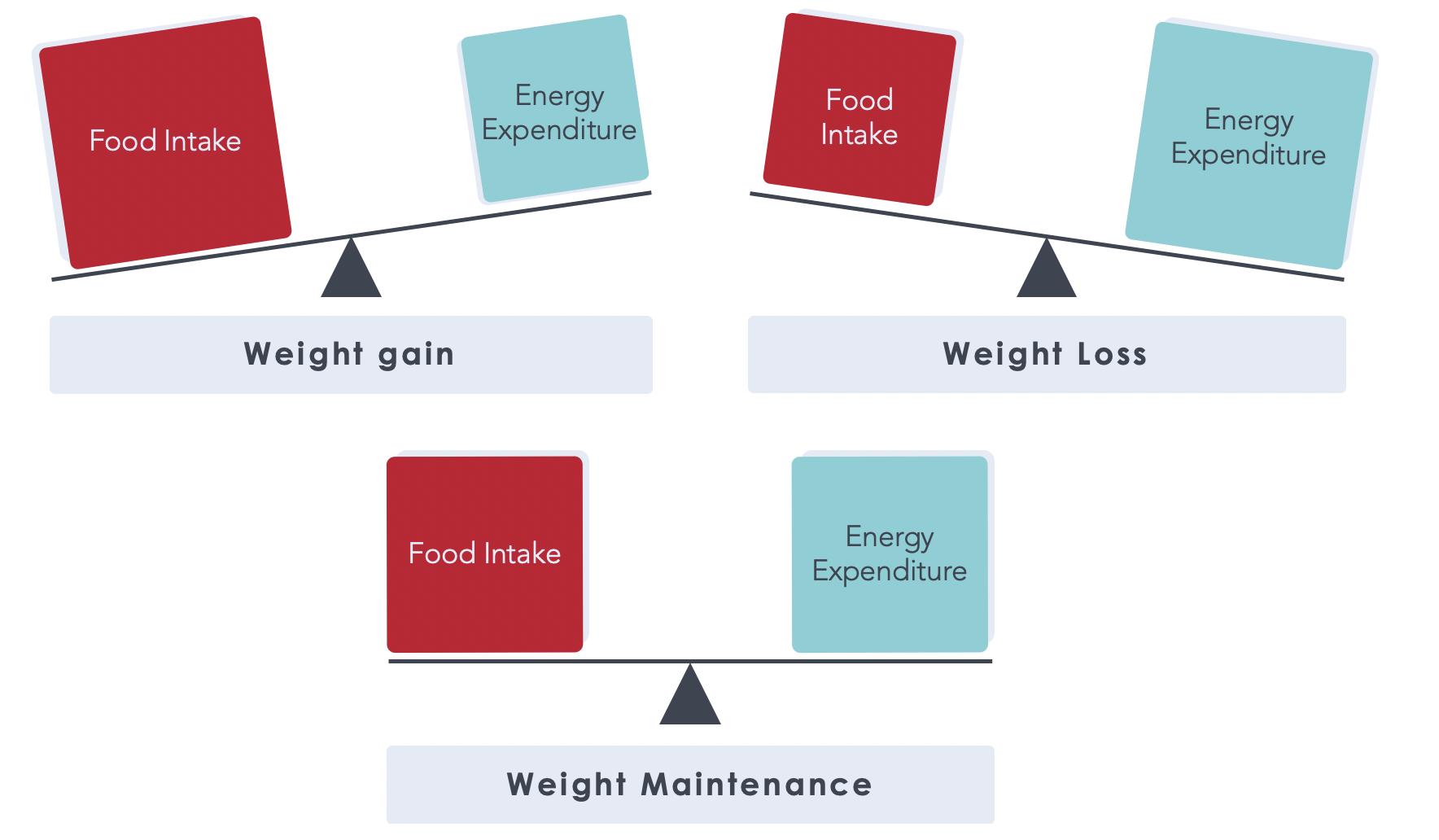How many times have you jumped on to the next fad diet, or high-intensity exercise boot camp, only to find you’re spinning your wheels?
Everyone intuitively understands that eating less and moving is probably a good idea in order to lose weight. In practice, though, many people find these concepts difficult to implement, especially over anything more than the short-term.
With the abundance of various dietary options available, the solution is usually to jump from one fad diet (or exercise regime) to the next, in the quest for the magic bullet that might finally work. Often these attempted changes do offer results for some time, but sustainability longer term is less successful. In fact, “studies show that one third to two-thirds of dieters regain more weight than they lost on their diets” (1)
Energy Balance: #1 Factor For Fat Loss
Whether you tried intermittent fasting, keto, or low carb, if you managed to lose body fat, it happened thanks to one thing: energy balance. Your energy intake from food (measured in calories) was lower than the energy you expended.
With that logic, there are essentially three states we can be in as it relates to weight loss:
- Gain weight: You consume more energy than you expend (calorie surplus), so your body stores the excess largely in the form of fat mass
- Lose weight: You expend more calories than you consume, so your body ‘burns’ energy (calorie deficit)
- Weight stable: You are in energy balance, consuming the same as you expend (calorie maintenance)
We can thus summarize energy balance in this neat little formula:
Change in body weight = Energy Intake (food) – Energy Expenditure
Note: the change in body weight can be a combination of both fat mass and muscle mass. You can manipulate things such that the weight loss is predominantly fat mass – more on that below.

Energy Expenditure – What is Metabolism?
The ‘energy in’ side of the equation is straightforward enough- it is what you eat. While there are multiple layers that can be tackled to optimise nutrition, at a high level, it is just as simple as total energy intake – the more you eat in calories, the higher your intake. This is the number one variable to manipulate in the quest for weight loss.
The ‘energy out’ side of the equation is what we call metabolism. It is composed of four components, that together make up total daily energy expenditure:
- Basal Metabolic Rate (BMR)
- Thermic Effect of Food (TEF)
- Non-Exercise Activity Thermogenesis (NEAT)
- Exercise Activity Thermogenesis (EAT)
Let’s break down these categories in order to best understand how to manipulate the ‘energy out’ side of the equation to our weight loss advantage.
Basal Metabolic Rate is the core of our metabolism, accounting for up to 70% of it. This is the energy required for bodily function, such as organ function, and energy required to sustain skeletal muscle mass. Think of it as the energy you would burn if you were laying down watching TV.
The Thermic Effect of Food arises as the body burns a portion of a consumed meal in order to process and digest. It varies substantially depending on how easy it is for the body to harvest energy from the chosen food. On an average western diet it is as low as 10%, but can go all the way up to 25% of energy expenditure.
Non-Exercise Activity Thermogenesis is the energy you burn through daily physical activity. Walking, standing at a desk, fidgeting, blinking – any physical movement outside of targeted exercise. NEAT can account for up to a whopping 30% of energy expenditure. It is significant.
Exercise Activity Thermogenesis is specific exercise activity. It is the energy/calories burnt when going for a run, taking part in a HIT class, strength training, amongst others. Generally this can account for up to 15% of total energy expended (unless you’re an athlete training for multiple hours daily).
Bringing It All Together
We’ve determined that ‘energy in’ must be less than ‘energy out’ for weight loss to occur. Reducing ‘energy in’ is the big hitter, e.g. reducing food intake. However, if you want to to eat more food and still lose weight, or accelerate weight loss at a given food intake, you need to manage energy expenditure too. How can you do that?
A large part of basal metabolism is outside of our control. You cannot control your organs’ use of energy. You can, however, manipulate the component of BMR that is linked to sustaining skeletal muscle mass. More muscle mass will contribute to a marginally higher BMR, and preserving muscle mass whilst losing weight will prevent an unnecessary drop in BMR.
Takeaway 1: make sure to include some amount of resistance training in your exercise program
Food thermogenesis is highly influenced by whether your meals mainly consist of processed foods or whole foods, with the latter offering greater energy expenditure benefits. (3) Of the three macronutrients, protein in isolation has the highest TEF at about 20%. A combined meal of protein, high-quality fats, and fibre will likely burn even more energy.
Takeaway 2: It is possible to literally put yourself in an energy deficit and start losing weight by eating the same amount of calories, but changing your dietary composition. Eat whole foods, with sufficient protein and fibre per meal, including whole food sources of omega-3 and monounsaturated fats (think salmon, avocado).
Non-exercise activity (NEAT) is also partly subconscious (you can’t control your blinking much), but we can manipulate the amount of movement we get in a day with simple walking, thereby pushing up NEAT significantly. An activity tracker may be useful in gauging your current activity and understanding how much you need to increase it.
Takeaway 3: Walk more and often! For tracking, 8,000 – 10,000 steps per day is a good target for significant increases in energy expenditure (or metabolism), and improved appetite regulation to boot.
Exercise activity accounts for the smallest portion of energy expenditure but carries significant benefits. Strength training, in particular, has the benefit of increasing BMR, but add in other forms of exercise you enjoy and have additional benefits for cardiovascular health and general well-being. This could be in the form of cardio, hIgh intensity interval training, sports, or other.
Takeaway 4: Incorporate regular training sessions, preferably with a base of resistance training at least 2-3 times per week.
Any dietary or lifestyle intervention for weight (or fat) loss will have an effect due to one or more of the above energy balance variables having been positively manipulated. Of these, the single most important factor is calorie intake, controlling the energy intake side of the equation. Optimising energy expenditure is highly beneficial. Aside from the associated health and aesthetic benefits, it makes calorie intake more manageable. The more food you can get away with eating, the more likely you are to sustain your program. Remember though, no matter how much you exercise to expend more calories, you cannot outrun a bad diet.
About the author
Cymron Bancil
After years juggling a senior banking career with my passion for fitness, I left finance to help busy professionals transform their bodies inside and out. As an online coach, I use a science-based approach to get you the lean, healthy physique you deserve.
Get my top research-led and results proven tips delivered right to your inbox via my free newsletter HERE.
References
- Mann, T., Tomiyama, A. J., Westling, E., Lew, A. M., Samuels, B., & Chatman, J. (2007). Medicare’s Search for Effective Obesity Treatments: Diets Are Not the Answer. American Psychologist, 62(3), 220–233.
- Trexler, E. T., Smith-Ryan, A. E., & Norton, L. E. (2014, February 27). Metabolic adaptation to weight loss: Implications for the athlete. Journal of the International Society of Sports Nutrition. BioMed Central.
- Barr, S. B., & Wright, J. C. (2010). Postprandial energy expenditure in whole-food and processed-food meals: Implications for daily energy expenditure. Food and Nutrition Research, 54.



